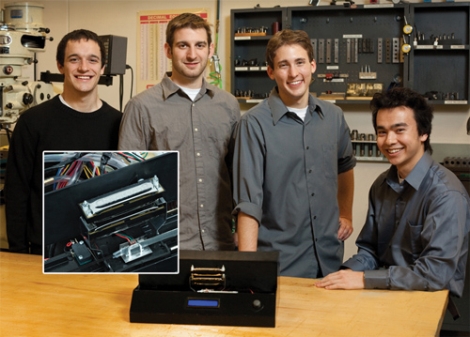
It seems that nearly everything is automated these days. Everywhere you look, people are being removed from processes in order to make them more efficient and less prone to mistakes. [Jon] however, saw one process that automation has yet to touch in a significant way – playing the harmonica.
He constructed a harmonica-playing machine that can play a handful of simple songs with a few button presses. The machine was constructed using three PIC controllers, an air compressor, and a pair of harmonicas. A master PIC controller manages the whole operation, taking input from the PIC driving LCD, then handing off playing instructions to the PIC that manages the harmonicas.
Once the machine is started and a song is selected, the machine plays away, prompting for a new song once it has finished. The machine doesn’t quite play the harmonica like a human does, however. The reeds of one harmonica were reversed so that the player only needs to blow air, rather than require a vacuum to provide suction for the drawing motion typically used in harmonica playing.
As you can see in this video, the rig works decently, though it probably needs a bit more work to achieve that “human” feel.
[Thanks, Ben]















Needs more advertisements.
Needs to play The Wizard.
If it would “look ahead” to the next note to be played, the motors could begin moving the air “ports” to the next note before the current note was finished, I think that would make it sound more “human”.
When I think of harmonica playing I think of a black and white film set in a ’30s prison, this thing is more like prison rape.
Needs to play “Bad to the Bone” for it to earn a spot in my heart… my gramps would play it for me and my cousins before bed RIP gramps!
I didn’t need to see their smug little faces.
I didn’t need to see their little faces.
Needs to be tuned.
Not bad although I was expecting air lines to go to each note with actuators controlling valves to each air line.
Hum… Somebody should learn music.
Automation 1870’s style. Organettes were the first use of the punched paper over heavy cardboard stock for automatic music. They are small tabletop reed organs. Pneumatic valves and relays weren’t made yet. The feeble air of suction with a reed was easily controlled with just a thin sheet of paper.
Also a big german company that has made harmonicas for more than a century has somewhere on it’s site an example of a real harp with a cardboard tunesheet. It looked prewar, there’s one shaped like the Hindenburg.
Lastly you can’t blow a harp well with a hose or lack of a cavity between the air source and the port of the reed.
very cool. john popper is still not scared.
Given that they modded the harmonica so vacuum was not required, it makes the whole endeavour slightly bogus in my mind.
If they’ve gone to the trouble of moving the air port with a printer head then they should have got the basics of the suck and blow mechanism sorted.
Otherwise, it would have been easier, and sounded way better to just make an organ-style reed blowing mechanism.
I’m not knocking their effort, but it’s just not finished yet. Show it when it’s done.
I thought about this before, and the problem is that you not only need to blow AND suck to get all the notes, but you need a cavity of changing volume to replicate the shape of the person’s mouth. This is how notes are bent – you make your mouth and throat smaller from a larger size and the note bends due to changing the resonant property of the whole system.
Unless they can make the system do all of this, they will not be able to play the harmonica the way a human does. The notes played in the video are way off because they can’t bend the notes.
There are also subtle techniques such as using the tongue or throat to do vibrato. Also, you use the tongue to make a an airtight seal before releasing and making a note, to give more attack to the notes. Not possible with this compressor setup.
It would be way better to have a compressor channel for all the reeds and make an automated reed organ.